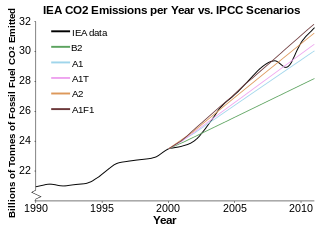Climate change mitigation
From Wikipedia, the free encyclopedia
Climate change mitigation consists of actions to limit the magnitude or rate of long-term climate change.[2] Climate change mitigation generally involves reductions in human (anthropogenic) emissions of greenhouse gases (GHGs).[3]Mitigation may also be achieved by increasing the capacity of carbon sinks, e.g., through reforestation.[3] Mitigation policies can substantially reduce the risks associated with human-induced global warming.[4]
"Mitigation is a public good; climate change is a case of ‘the tragedy of the commons’" Effective climate change mitigation will not be achieved if each agent (individual, institution or country) acts independently in its own selfish interest, (SeeInternational Cooperation and Emissions Trading) suggesting the need for collective action. Some adaptation actions, on the other hand, have characteristics of a private good as benefits of actions may accrue more directly to the individuals, regions, or countries that undertake them, at least in the short term. Nevertheless, financing such adaptive activities remains an issue, particularly for poor individuals and countries."[5]
Examples of mitigation include switching to low-carbon energy sources, such as renewable and nuclear energy, and expanding forests and other "sinks" to remove greater amounts of carbon dioxide from the atmosphere.[3] Energy efficiency may also play a role,[6] for example, through improving the insulation of buildings.[7] Another approach to climate change mitigation is climate engineering.[8]
Most countries are parties to the United Nations Framework Convention on Climate Change (UNFCCC).[9] The ultimate objective of the UNFCCC is to stabilize atmospheric concentrations of GHGs at a level that would prevent dangerous human interference of the climate system.[10] Scientific analysis can provide information on the impacts of climate change, but deciding which impacts are dangerous requires value judgments.[11]
In 2010, Parties to the UNFCCC agreed that future global warming should be limited to below 2.0 °C (3.6 °F) relative to the pre-industrial level.[12] This may be revised with a target of limiting global warming to below 1.5 °C relative to pre-industrial levels. The current trajectory of global greenhouse gas emissions does not appear to be consistent with limiting global warming to below 1.5 or 2 °C, relative to pre-industrial levels.[13] Other mitigation policies have been proposed, some of which are more stringent[14] or modest[15][16] than the 2 °C limit.












0 comments:
Post a Comment